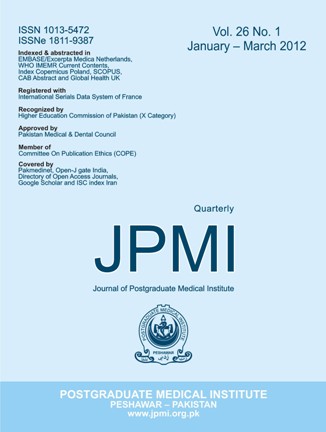THE FREQUENCY OF MALIGNANCY IN NODULAR GOITER - A SINGLE CENTER STUDY
Main Article Content
Abstract
Objective:
To find out the frequency of malignancy in nodular goiters.
Methodology:
A total of 204 cases were studied in the department of ENT and Head and Neck Surgery,
Hayatabad Medical Complex, Peshawar. The duration of this descriptive study was from June 1, 2008 to
May 31, 2010. After taking informed consent, a detailed history was obtained. Clinical and laboratory
investigations were carried out as an aid to diagnosis and determine the patients' fitness for surgery.
Patients with nodular goiters were categorized into two categories i.e., Solitary thyroid nodule and
multinodular goiter. Surgically resected thyroid specimens were examined histopathologically. The data was
analyzed using SPSS 16.0 for windows to determine the frequency of malignancy in nodular goiter.
Results:
Ages of the patients ranged from 17 to 84 years with a mean age of 37 + 12.48 years. The male
to female ratio was 1:3.5. 18.14% cases presented as solitary thyroid nodules (STN) and 81.86% as
multinodular goiters (MNG). Out of the total 83.82% cases were benign and 16.18% cases were malignant.
The prevalence of malignancy in multinodular goiter was 14.37% and in the solitary thyroid nodules as
24.32%. Papillary carcinoma was the commonest malignancy followed by follicular carcinoma.
Conclusion:
The prevalence of cancer is significant in nodular goiters and these malignant tumours are
usually of the papillary type. Solitary thyroid nodules have more chances of being malignant than
multinodular goiter.
Article Details
Work published in JPMI is licensed under a
Creative Commons Attribution-NonCommercial 2.0 Generic License.
Authors are permitted and encouraged to post their work online (e.g., in institutional repositories or on their website) prior to and during the submission process, as it can lead to productive exchanges, as well as earlier and greater citation of published work.


